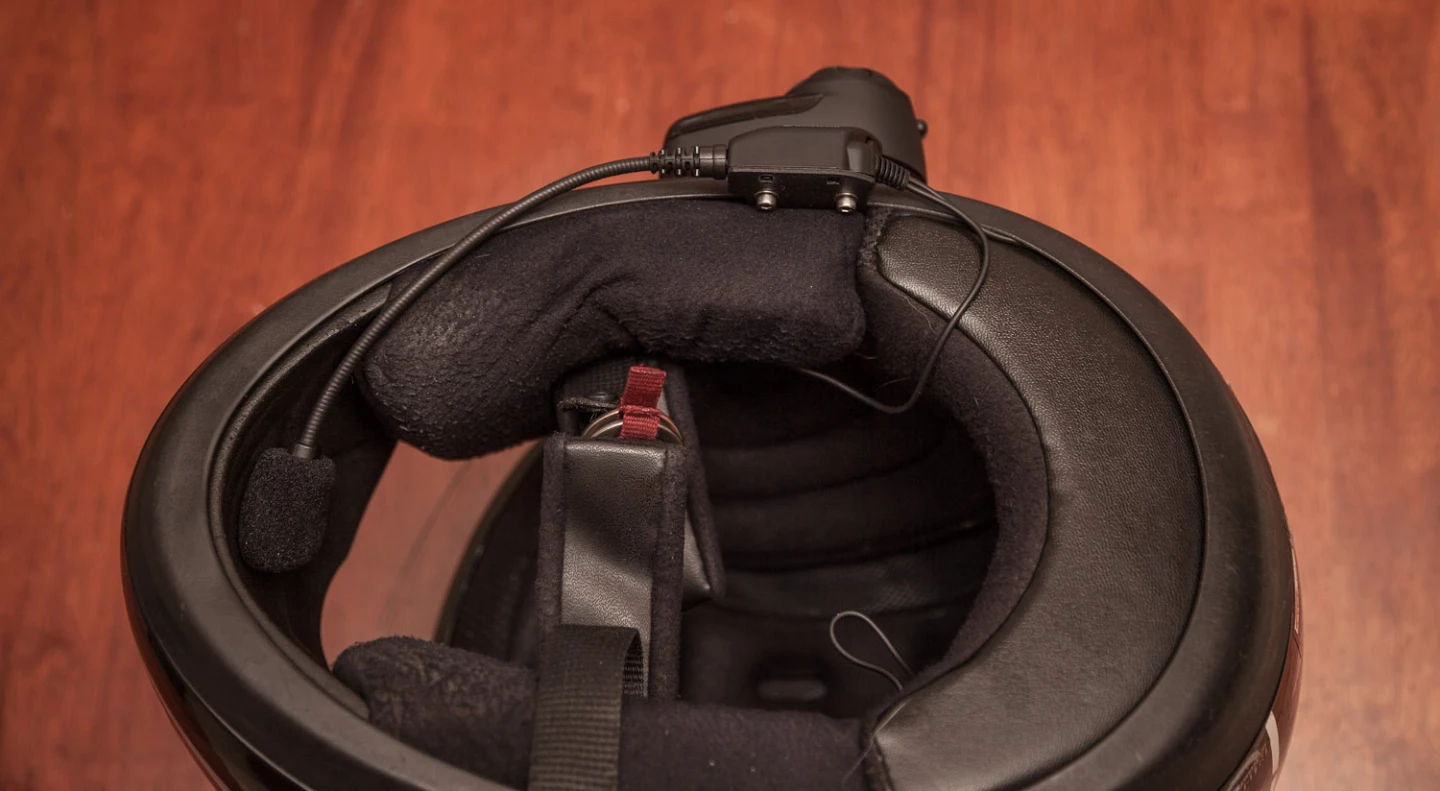I'll admit I wasn't looking forward to testing another Bluetooth helmet system. My experience in the past with Nolan's old N-COM unit on an N102E helmet had set my expectations: the installation would be a pain in the bum, pairing it to a phone would be a hit and miss affair, it would be confusing to use, the battery would fade quickly and I'd have to remember what a bunch of different beeping sounds meant in order to know what the heck button I'd pressed or what the thing was doing at a given time. I'm glad to say, with Sena's SMH10 unit, it looks like things have moved along a bit!
Firstly, let me say this – if you're remotely interested in getting yourself one of these, budget for two or more – because the SMH10 is so quick and easy to fit to most helmets that you'll want to keep a spare to throw to your riding buddies when you're going out with them.

Installation
To install the kit, you just push the clamp up in between the helmet shell and liner, and tighten a couple of hex screws. You then velcro the earpad speakers into the ear holes in your helmet liner and tuck the wires away. Job done, ready to ride. I've stuck this jigger on half a dozen lids so far with only one failure – that sadly being my favorite lid, the Nolan N104, which has an oddly shaped piece of padding that won't let me get the clamp in. I had no similar trouble with an older N103.
On one particular low-sided lid, I found the slightly chunky headset was restricting me from making left-side headchecks on a sportsbike. This wasn't a problem on other helmets or more upright bikes – or even for another rider wearing the same helmet on the same sportsbike. And it wasn't a huge issue – I just had to be aware and lift my chin a bit when turning my head left.
Once installed, the Sena headset is simply a joy to use. I had it paired with iPhones and Android phones in a matter of seconds. The intercom pairing process is a little fuzzy – you're not quite sure if it's working. But for most other things, the SMH10 gives you little voice prompts like "phone connected," "battery level: low," or "media connected." Such a simple thing to add, but these voice prompts make a huge difference to the unit's usability.
Likewise, the controls are fantastic to use with gloved hands. There's one button on the back, and one big jog dial/combination button on the side. The back button does phone stuff, the side button does intercom stuff, and the jog dial handles volume. You can push the intercom button in and rotate the dial at the same time to switch tracks on your music player. The basic functions are incredibly simple and easy to get used to – this is in direct contrast to other systems (coughNCOMcough), where I often found myself hunting for buttons, and unsure of what I'd pressed.

Bluetooth helmet intercom function
It's amazing how far apart you can be and still have a Bluetooth connection these days! You can connect up to four headsets as an intercom conference, although that could get pretty confusing on the road. I only ever had one other helmet connected, and I found it an absolutely transformative riding experience.
For starters, if you've got a pillion on, you can suddenly hold a conversation that consists of more than just hand signals, leg squeezes and repeated kidney punches.
If you're out riding with a buddy, you no longer have to stick together or wait for each other in traffic – if they get caught at a red light, or stuck behind a bus, or they freak out, or see a particularly attractive pedestrian, they can tell you immediately.
Riding with a less confident rider, you're able to watch them and give them feedback and advice in real time, which I found super helpful. It accelerates learning, builds and reinforces confidence very quickly, and gives learners instant insight into what a more experienced rider is seeing in traffic patterns or technique issues. Just be prepared to say "cancel your indicator" a zillion times.
Sena advertises the SMH10 as having a 900-meter (980 yard) range in open terrain. Our test showed more like 500 meters (550 yd) with line of sight, but we were testing in an urban environment, and one of the headsets was getting low on battery. Either way, the intercom range is extremely useful. If you get out of range or pass behind a large building, the signal gradually degrades into a messy digital soup, then cuts out altogether. But it instantly and automatically re-pairs when back in range.

Phone functions
When paired with a smartphone, the SMH10 works pretty seamlessly. If somebody calls you mid-ride, you can answer the call by simply making a noise into the microphone, or hitting a button. You can access Siri or voice dialing by tapping the rear button once, and the mic quality is good enough to make the voice dialing process usable on the road.
Likewise, you can use navigation or audio players on your phone with ease. You can also pair with a range of other Bluetooth devices like GPS units and the like, or plug a non-Bluetooth audio player into the 3.5 mm audio jack recessed into the clamp unit. The SMH10 runs these devices in priority sequence – phone calls take precedence, while music players are least important.

Audio quality
In a word, extraordinary. At highway speeds in an open-faced or full face helmet, road and wind noise on your microphone is almost magically eliminated. You can still hear the revving of your partner's motorcycle engine, but the voice quality is so good that people on the other end of phone calls will frequently tell you to stop yelling, they can hear you just fine. At 80 km/h (50 mph) and above, I found myself speaking so quietly that I couldn't hear my own voice – and yet the Sena unit transmitted it quite clearly through the phone or intercom.
The speaker units deliver a surprisingly loud volume when cranked up – ear-splitting at a standstill but perfect if you ride with earplugs in. With a full-face helmet you can hear very clearly even when you're traveling a freeway speeds. With an open face, the external wind noise starts to make things difficult to hear at about 100 km/h (62 mph).
Music sounds pretty good too – still nothing on a pair of ear molds or a car stereo, but not bad.
The one combination I found that didn't work was taking a pillion with an open-faced helmet. I suspect it was the turbulent wind coming off my own helmet that confused the Sena unit's noise cancellation, but either way, wind noise built up until we had to switch the intercom off.
One other nifty feature is that each audio input – say, phone, intercom, and music – retains its own volume setting. So if you have to jack up the volume for a quiet song, you won't blow your eardrums out when you get a phone call. And yes, the speakers can be so loud that this is a genuine concern.

Battery life
The SMH10 is rated for a massive 10 days' standby time and 12 hours of talk time off a single two-hour charge. We ran one of the headsets down quite low within a couple of short rides – but I suspect my missus may have left it on, constantly pairing itself with whichever phone walked past, for several days in between rides.
The longest single jaunt I've taken it out for has been a two-hour ride of constant intercom talking, and that didn't seem to make much of a dent in the battery life. Either way, you charge the units through USB, whether it's off a computer, a power adapter (not supplied) or through a cigarette lighter attachment. So I fully believe that if you remember to switch it off when you get off the bike, the SMH10 is good for a full day's chatting with your ride buddies on tour – and maybe two days, depending on how much time you spend on the road.
Overall
The Sena SMH10 has really changed my mind about helmet Bluetooth systems. It's simple and intuitive, its audio performance is truly impressive, the intercom function is brilliant and device integration almost seamless. It's actually quite a lot of fun to use, and it adds a lot to your riding experience.
Best of all, you can throw an SMH10 on your buddy's lid in three minutes flat if you're going out riding together. I wouldn't mind betting a few of your mates will go pick up a set for themselves after trying it.
Currently, you can pick up a pair of SMH10s in a dual pack for less than US$300 brand new on eBay. That's US$100 cheaper than some stores are selling a single Nolan N-COM unit for. It's also considerably cheaper than the Scala Rider G9 dual set – although the Scala system is advertised to have a significantly longer Bluetooth range (1.6 km (1 mile) vs. 900 m (980 yd)) and a slightly longer battery life (13 vs. 12 hours of talk time.)
Either way, I think most riders will enjoy using the SMH10 – and without the benefit of long-term, long-ride and bad weather reliability testing, our early impressions are that this is a fantastic gadget.
Product page: Sena SMH10




















